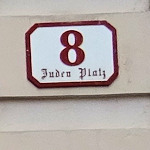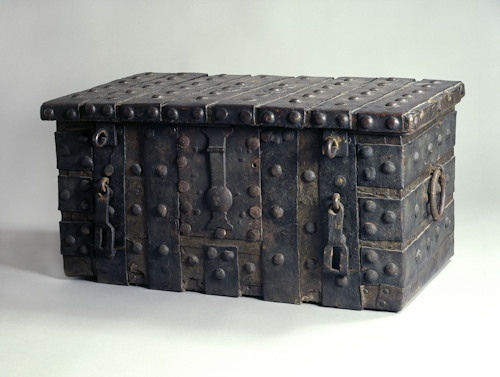
Guilty! A word often spoken with confidence. And yet there are far more versions of guilt than just the simple legal decision. An exhibition at the Jewish Museum presents some of the alternatives.
- From religious origins to today’s existential guilt
- Each dimension includes an accompanying artwork or historical object
- Opens your eyes to nuance and self-reflection
- Runs March 28th to October 29th, 2023
- See also:
Guilty in more ways than one

(“Tetzelkasten” (indulgence box of the Dominican monk Johann Tetzel), early 16th century. Oak, iron fittings, Städtisches Museum Braunschweig © Städtisches Museum Braunschweig)
Guilt is one of those words that seems a relatively simple concept at first glance. And then you dig a little deeper and discover all the variations on the theme. And then you dig even deeper and start to explore your own feelings in these different contexts.
That, essentially, is the visitor experience at the Guilt exhibition.
The Jewish Museum’s Judenplatz site lies above a medieval synagogue and next to a Holocaust Memorial. And, rather aptly, the exhibition inside sits nicely between the two both physically and conceptually.
One room introduces guilt seen through the lens of religious history. Another looks at more diverse and modern understandings of the word.
Each form of guilt comes with a brief explanation and an illustration in the form of an object, artwork, photo, document, video or similar.
We learn in the religious section, for example, of the origins of guilt through the story of Adam and Eve within the Judeo-Christian tradition, but also of the different nuances of this guilt according to your faith.
Other dimensions of guilt here include the idea of buying redemption, where individuals obtain an indulgence through certain actions or donations.

(Nuremberg Trials: Bench with Nazi Regime Defendants, 1945. Photograph, Deutsches Historisches Museum © Press-Image Roehnert/Deutsches Historisches Museum)
We see, for example, an indulgence box used by the Dominican monk Johann Tetzel (c. 1460-1519), whose questionable “pardons-for-cash” activities prompted Martin Luther to put pen to paper and start the process that led to the Reformation.
The Shoah provides a resonant context for various modern sociopolitical understandings of guilt (such as survivor guilt, inherited guilt or suppressed guilt).
A 1965 painting of his uncle (an officer in the German army during WWII) by Gerhard Richter accompanies the case of collective guilt. Richter, of course, has gone on to an illustrious career in contemporary art that sees his works sell for 8-figure dollar sums.
But the “Nazi experience” is not the only focus here.
For example, how do we feel about the role of our smartphone use in driving socioeconomic problems in regions that produce the raw materials for phone manufacturer? How do we feel about living a comfortable life when others suffer?
The overall impression acts as a reminder that simple concepts can hide complex meanings. And nuance (an increasingly strange concept in social media-driven debates that allow only extremes) is everywhere.
And, inevitably, you find yourself questioning what senses of guilt you may feel yourself and whether they are proportionate to their cause.
Dates, tickets & tips
Explore the different facets of guilt from March 28th to October 29th, 2023. An entrance ticket to the Jewish Museum from a valid source includes the exhibitions.
Some of the themes touched on in Guilt feature in exhibitions elsewhere in Vienna. For example, Mining Photography looks at the sociopolitical and environmental impacts of photo production through the ages.
The House of Austrian History tackles local history post-WWI, which includes that infamous era which has implications for issues like shared and inherited guilt.
How to get there
Check the main Jewish Museum article for details. You want the Judenplatz site, where the exhibition occupies the ground floor.
Address: Dorotheergasse 11, 1010 Vienna